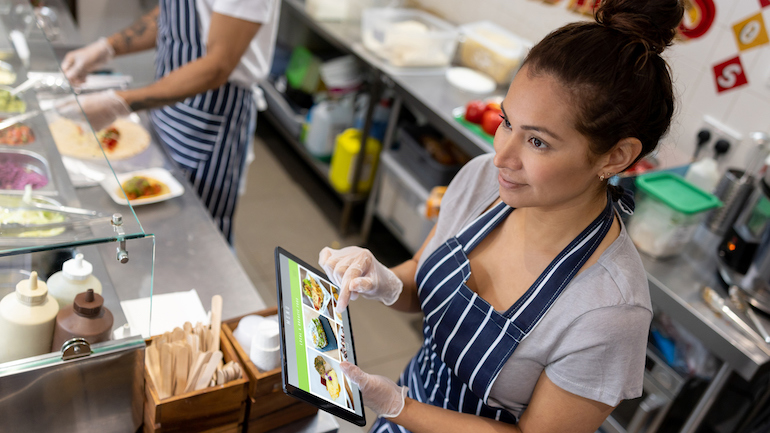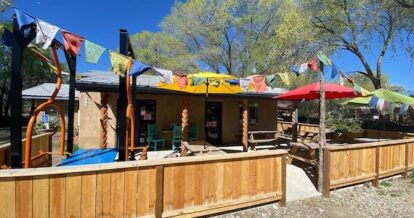The restaurant industry has made many pivots over the years to keep up with industry trends and demand. One of those pivots is the transition from a legacy or traditional point of sale (POS system). This refers to the switch from the clunkier, physical hardware systems used to manage restaurant operations, to cloud-based POS systems that are connected to the Internet and allow you to remotely manage your restaurant operations.
According to our 2024 State of Restaurants Report, 76% of full service restaurant operators in the U.S. currently use a cloud POS system, which means the majority of restaurant owners have made the switch. With cloud-based POS systems now mainstream technology, it may be time to re-evaluate your own restaurant’s way of operating by putting some of the most common cloud misconceptions to rest. In this article, we’re going to discuss three common cloud myths and set the record straight so you’re armed with the correct information about this crucial technology. These myths include:
- Cloud POS systems are expensive
- Cloud POS systems are complicated
- Cloud POS systems can’t be used offline
Let’s get started and debunk these three common misconceptions about cloud-based POS systems!
Myth #1: Cloud POS Systems Are Expensive
One of the most common cloud myths about cloud-based POS systems is that they’re expensive. Similar to all new technology, the high price tag attached with purchasing a cloud-based POS system initially wasn’t worth the spend for all restaurant owners – especially smaller run businesses. Knowing how much a traditional or legacy POS had cost, it was only fair for restaurateurs to assume that a newer piece of technology would be the same. Restaurateurs in the past also thought that due to a subscription-based model, payments of cloud-based POS systems will be more costly than the upfront costs of a traditional or legacy POS system.
However, these initial concerns are no longer the case, especially if you need a POS system to run multi-location restaurant operations.
Reality: Cloud POS Systems Are Affordable
The reality is, cloud-based POS systems are in fact more affordable than traditional POS systems since you don’t need to purchase or maintain expensive hardware, according to Forbes. And if you run more than one restaurant location, purchasing a legacy POS system may actually be the option that breaks the bank.
Let’s break it down further and see what the typical costs entail for a legacy POS system versus a cloud-based POS system, and where the cost savings lie for restaurateurs.
Legacy or more traditional POS systems generally come with higher costs, especially upfront ones. While a legacy POS system does not require Internet, as it’s a standalone system, it has hefty installation fees and hardware fees that cost upwards of $20,000 for both. There are also software costs that need to be taken into account, whether that’s paid upfront or as a monthly fee.
On top of all that, you need to consider the ongoing repair and maintenance needed to upkeep the on-premise POS system, since someone physically needs to show up to your venue to fix the equipment. All these costs can ultimately make a huge dent in your restaurant’s budget.
On the other hand, cloud-based POS systems are highly affordable due to the minimal upfront and ongoing costs required from restaurant owners. Unlike a legacy or traditional POS system, a cloud-based POS system only requires a predictable monthly fee for the software itself, with no hefty training or maintenance fees attached. Cloud-based systems are also generally run on relatively inexpensive hardware like mobile tablets, making it quick and cost-effective to scale.
How Can a Cloud-Based POS Help You Save Costs?
Cloud-based POS systems come with many hidden cost savings, which makes these systems even more affordable and attractive for today’s operators. The major cost savings come from automation, which helps eliminate manual entry, thereby reducing order errors that restaurateurs and staff may make. And with fewer errors, less food is wasted and less voids are processed, ultimately protecting your bottom line.
TouchBistro’s all-on-one restaurant management platform, powered by the cloud, is a prime example of a POS system that delivers these hidden cost savings. TouchBistro’s cloud-based POS software allows restaurant staff to take orders tableside, and then digitally process those orders, so the chance of inputting an incorrect order is limited. When staff use this method to take orders, it allows them to turn over tables quicker due to operational efficiency, ultimately helping you process more sales.

Myth #2: Cloud POS Systems Are Complicated
The second cloud security myth is that operating cloud POS systems are overly complicated. It can be difficult to adapt to something new, especially if it’s something you don’t have any experience with or know next to nothing about. If you’re used to operating a traditional POS system, or even taking orders manually on pen and paper, these processes will naturally feel more familiar. Therefore, it’s understandable that cloud-based POS systems can seem like they come with a big learning curve.
Reality: Cloud POS Systems Are Extremely Intuitive
Despite how intimidating new tech can feel, the reality is that legacy or traditional POS systems have become outdated, as it’s an interface that people are not as familiar with anymore. And over the past decade, restaurateurs have been increasingly using cloud in their personal life, such as with online banking, Google docs, and to store their photos in the cloud. Over time, these habits have seeped into business as well, as restaurant operators also began using the cloud in their restaurants, specifically adopting a cloud-based POS system to run everyday operations. While not every operator has experienced a perfect transition, as the restaurant industry has evolved, cloud-based POS systems have only become more intuitive, helping restaurant owners achieve operational efficiency.
Let’s dive deeper into how a cloud-POS system takes the user into account when it comes to daily operations, ultimately delivering a more intuitive experience for you and your staff.
Knowing that people of all tech abilities work in restaurants, cloud-based POS providers have taken the time to specifically create a user-friendly software experience. A great example of this is TouchBistro’s own bill-splitting feature, which allows users to easily and quickly split bills between customers with just a few swipes. Built with actual servers in mind, these kinds of intuitive interfaces mean that there generally is no major learning curve for restaurant staff to use cloud-based POS systems.
How Can a User-Friendly POS Help You?
With a cloud-based system being a much simpler system to train staff correctly, staff will learn and adapt quickly. And as a result, it can help decrease miscommunication between the front and back of house, as well as eliminate chances for manual errors. And when issues do arise, most cloud-based POS system providers will provide restaurateurs with on-demand support. As a bonus, many fixes and updates can be done remotely, without having to wait on a maintenance team to make fixes or updates on your restaurant premises.
And all of this technology is not static. Cloud-based point of sale systems are designed to evolve as the restaurant industry changes and as cloud technology changes, so you never fall behind the curve.

Myth #3: Cloud POS Systems Can’t Be Used Offline
The third and final cloud security myth we’re going to debunk is that cloud-based POS systems are only accessible through Internet access.
In contrast to legacy systems, which are hardwired in the venue, cloud-based systems rely on an Internet connection to operate. As a result, some restaurant operators believe that if there is no Internet access, their POS system will no longer work and that it will halt their restaurant operations. And no operator wants to live in fear and take that chance, as it can obviously impact their sales and service.
This is one of the more common cloud misconceptions about the use of cloud-based POS systems, although it’s not entirely true.
Reality: Most POS Systems Have a Built-In Offline Mode
So, what makes this one of the most common cloud computing myths? The fact is that some cloud POS features do indeed pause when the Internet goes down, so it’s rightfully a common cloud misconception. Some of the features that are not accessible without an Internet connection can include, but are not limited to, changing your menu, accessing online orders or reporting, and editing your floor plan. However, the most essential POS features – such as the ability to take orders and send orders to the kitchen – will still work, all thanks to a special feature called offline mode.
Did you know that today most cloud-based POS systems are designed with a built-in offline mode? And with POS offline mode, you can still run your restaurant operations without Internet access.
How Can POS Offline Mode Help You?
Let’s say the Internet connection goes down at your restaurant due to a massive thunderstorm outside. Fortunately for you, if you have a cloud-based POS system equipped with offline mode, like TouchBistro’s cloud-based POS system, your kitchen and dining service will not be interrupted. You can continue to take and close orders, send orders to your kitchen display system (KDS), and take offline payments.Hopefully, we have crushed these three cloud computing myths and shed more light to the world of cloud-based POS systems. As a reminder, it’s always beneficial to research the best restaurant POS systems and see which type of POS system (whether it’s legacy or cloud-based) will be the best fit for your business.
Get the Complete Guide to Restaurant Reservations







